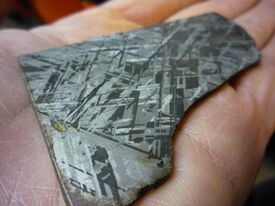Astronomy:Iron–nickel alloy

An iron–nickel alloy or nickel–iron alloy, abbreviated FeNi or NiFe, is a group of alloys consisting primarily of the elements nickel (Ni) and iron (Fe). It is the main constituent of the "iron" planetary cores and iron meteorites. In chemistry, the acronym NiFe refers to an iron–nickel catalyst or component involved in various chemical reactions, or the reactions themselves; in geology, it refers to the main constituents of telluric planetary cores (including Earth's).
Some manufactured alloys of iron–nickel are called nickel steel or stainless steel. Depending on the intended use of the alloy, these are usually fortified with small amounts of other metals, such as chromium, cobalt, molybdenum, and titanium.
Astronomy and geology
Iron and nickel are the most abundant elements produced during the final stage of stellar nucleosynthesis in massive stars. Heavier elements require other forms of nucleosynthesis, such as during a supernova or neutron star merger.[1][2] Iron and nickel are the most abundant metals in metallic meteorites[3] and in the dense metal cores of telluric planets, such as Earth.
Nickel–iron alloys occur naturally on Earth's surface as telluric iron or meteoric iron.
Chemistry and metallurgy
The affinity of nickel atoms (atomic number 28) for iron (atomic number 26) results in natural occurring alloys and a large number of commercial alloys. The surfaces of these metallic compounds provide a complex electron environment for catalyzing chemical reactions.[4]
In steel metallurgy, nickel is alloyed with iron to produce maraging steel and some low-alloy steels. Other technological uses include Invar and Mu-metal.
Alloy summary
The following table is an overview of different iron–nickel alloys. Naturally occurring alloys are a type of mineral and called native elements or native metals. Some of the entries have more than one crystal structure (e.g. meteoric iron is a mixture of two crystal structures).
| Name | Description | Chemical formula / Weight percent nickel |
|---|---|---|
| Antitaenite | An intermetallic compound found in meteorites[5] | Fe3Ni |
| Awaruite | A native intermetallic compound found in serpentinites and meteorites | Ni2Fe to Ni3Fe |
| Earth's core | Earth's core is composed of an iron–nickel alloy[6] | about 5.5% Ni |
| Elinvar | A manufactured alloy whose elasticity does not change with temperature; 5% Cr | 36% Ni |
| Invar | A steel manufactured to have a very low thermal expansion | 36% Ni |
| Kamacite | A native metal found in meteoric iron | Fe[0.9]Ni[0.1] |
| Maraging steel | A strong, malleable variant of steel | 15–25% Ni |
| Meteoric iron | A native combination of mostly kamacite and taenite, and minor amounts of tetrataenite, antitaenite, and awaruite | 5–30% Ni |
| Mu-metal | An alloy manufactured to be highly permeable to magnetism | 77% Ni |
| Planetary core | Planets, moons, and planetesimals can have cores of various iron–nickel alloys | various |
| Stainless steel | A variant of steel manufactured to be corrosion-resistant, with Cr as well as Ni | 4–8% Ni |
| Taenite | A native metal found in meteorites | NiFe |
| Telluric iron | A native metal found on Earth (distinct from extraterrestrial irons) | 0.05%–4% Ni |
| Tetrataenite | A native metal found in meteorites | FeNi |
See also
References
- ↑ Wannier, P.G. (1980). "Nuclear abundances and evolution of the interstellar medium". Annual Review of Astronomy and Astrophysics 18: 399–437. doi:10.1146/annurev.aa.18.090180.002151. Bibcode: 1980ARA&A..18..399W.
- ↑ Johnson, Jennifer A. (2019). "Populating the periodic table: Nucleosynthesis of the elements". Science 363 (6426): 474–478. doi:10.1126/science.aau9540. PMID 30705182. Bibcode: 2019Sci...363..474J.
- ↑ Mason, Brian Harold (1971). Handbook of Elemental Abundances in Meteorites. New York, NY: Gordon and Breach. ISBN 0-677-14950-6.
- ↑ Pardo, A.; de Lacey, A.L.; Fernández, V.M.; Fan, H.J.; Fan, Y.; Hall, M.B. (2006). "Density functional study of the catalytic cycle of nickel-iron NiFe hydrogenases and the involvement of high-spin nickel(II)". Journal of Biological Inorganic Chemistry 11 (3): 286–306. doi:10.1007/s00775-005-0076-3. PMID 16511689.
- ↑ "Antitaenite". Hudson Institute of Mineralogy. http://www.mindat.org/min-6804.html.
- ↑ Lin, Jung-Fu (1 January 2002). "Iron-Nickel alloy in the Earth's core". Geophysical Research Letters 29 (10): 109‑1 – 109‑3. doi:10.1029/2002GL015089. Bibcode: 2002GeoRL..29.1471L.
 |

